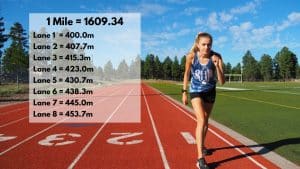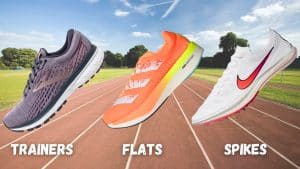Unless you’ve spent a bit of time on the track you can finding it to be a very intimidating place. And confusing. Very confusing.
I mean do you honestly understand all those marks everywhere? Seemingly placed in random fashion. As if they are a foreign language.
Let’s Start With A Quiz
So let’s see how well versed you are on the language of the track.
- Question 1: If you run four laps of a 400M track is that equal to a mile?
- Answer: No
- Question 2: If you run four laps in lane 2 of a 400M track is that equal to a mile?
- Answer: No
- Question 3: Is a “metric mile” 1600M?
- Answer: No
So how’d you fair? Think perhaps you should keep reading? Great. Let’s do some education.
Bonus Content
Author of this post, coach and lover of the track Tony Pallotta shares more in this special video.
Like this post? Please share it.
How To Measure Distance
On a track it’s easy to be unsure of how far you ran. Especially for those US runners. I mean do you measure in non-metric units like feet, miles, inches, etc? Or metric units like centimeters, meters or kilometers? Put me in the former.
So question 1 above, the answer is no because a mile is actually 1609M. Four laps of the track is 9 meter shorts. Not a huge number. But if you’re doing a tempo run on the track then it does add up.
To measure distance on a track you need to start backwards. Everything works from the finish line. Find the finish, then go “back” to find the start.
In the case of the mile, you first find the finish, then knowing you are running 9M “longer” than 4 laps you need to go behind the finish line and you’ll see a line across all lanes, indicating the start of the mile.
It’s from there you run 9M to the “finish” then 4 more laps and voila. You just ran an honest mile.
What about question 3? A metric mile is 1500M (though hard core track athletes may argue otherwise). So in that case you need to move “ahead” of the finish line by how much? Yes, 100 meters. So you are running “100 meters short” of 4 laps or 1600M.
Not All Lanes Are Equal
For those non-science people there’s another phenomenon. Running outside of lane one means running further. It’s why in a race you may see twenty plus people all trying to cram into lane one.
No, they are not trying to bond. Nor unaware there are six or seven more perfectly good lanes wide open. Rather they are trying to run the race distance. No longer.
So how much longer is each lap? Here’s a graphic to show.

Ever wonder why you are so much slower on the track than the roads? I bet it’s because you’re running outside of lane 1. In other words you are likely running the same pace, maybe even faster. You’re just running further but assuming less.
Etiquette
Which brings us to our next vitally important topic. Etiquette. Yes there are rules on a track. Unwritten and often the source of confrontation. Usually just words exchanged.
So we know the importance of lane one. Everyone should in lane one. But only at the respect of others.
Walking in lane one is fine if no one else is on the track. Or if others are on the track only while no one is near you. Or if you are a slower runner, then you need to either stay out of lane one when busy or be aware of others if not busy.
Why? Because it’s easy to get hurt on the track. Easy to run into a slower runner. Though it may sound inflated, trust me it’s not. I’ve run into people before. And been run into.
The bottom line is you need to respect lane one. If someone is coming up on you, running faster, then move to a lane outside of where they are. So if you are in lane 1, and a runner is coming up on you, move to lane 3 or 4. Give them the chance to safely pass (on your left side) and then you can move back in.
What Are All Those Marks
Those marks are not random. There’s a method to their madness.
So a track is 400M around for one lap. A 200M race then would start exactly half way around. A 600M race would start in the same place right? Yes. You’d run 200M to the “finish” then another 400M, one lap, and the race is over.
An 800M race, half a mile (minus the 4.5 M if you have been playing along at home) starts at the “finish” and runs two laps to completion.
Those are somewhat easy. But what about the turns? What appears to have been a group of kids experimenting with spray paint on a Friday evening is anything but. There too, a strategy is at hand.
Those markings are for relays. Remember the 4 by 100M relay in the Olympics or other televised track meets? Each member of the relay works in a “zone.” Within this zone the baton can be touched by two people simultaneously.
The person passing the baton to the person receiving it. Outside of the zone only one can be touching. Failure to pass within the zone properly means you are disqualified.
So unless you racing the “4 by 1” it’s safe to say, the vast majority of us can forget about those marks.
What Do I Wear

Aside from “running clothes” obviously stated, let’s talk footwear. Can you wear road shoes on the track? For sure. And many do.
Other options are either flats (lightweight road shoes essentially) or “spikes.” Flats are typically best worn only for the workout. So do your “warm up and cool down” in your road shoes. Switching to your flats only for the workout.
The same is true with spikes. Which are essentially as minimalist as you can get with metal spikes screwed in. But here’s the important note. Because tracks are not cheap to install. Meaning the athletic director, coach, etc wants to make sure it’s properly used.
You need to wear the right size spike. For example if the track only allows 1/8th inch spikes and you wear 1/4 inch then you are likely damaging the track. And it’s not a matter of “getting caught.”
It’s more being respectful. And making sure the track is there for you and everyone else for years to come.
For more on footwear, please read How To Decide If Racing Flats Are For You.
How About A Race
So aside from doing workouts, don’t shy away from a track race. Sure it’s intimidating. But only until you hear the gun fire. After that it’s really awesome.
And you’ll realize track athletes are as inviting as road runners. Granted a little more attitude purely because of the intensity of the race. But the same, good, down to earth people on the road. After all they too run the roads.
Many communities have open track meets. Growing up in Boston it was awesome to run the Twilight Series at Northeastern. At 30 I was in racing college and non-college runners. All based on my “seed” time.
An honor system if you will. Where you estimate your finish time and “heats” or races are selected based on similar times. So don’t lie.
I’d run my race or two. Then after the elites would come in. Often those trying to run trial qualifiers in various distances. A who’s who of elites. It was cool.
There’s even races for seniors. In fact you’ll often find a lot of seniors racing the track.
So enjoy a race. Take it in. And though it’s intimidating get through those initial nerves. And feel the joy of racing the track.








3 Responses
So who passed the test above?
What lead me to this page was a search for a picture of the old “lane use” sign that Bowerman put up at Hayward Field in the 1970’s. Didn’t find it, but this page is a great resource to share with others. All the info in one place! The old sign said “lanes 1-2 for running”, and I believe “lanes 3-6 for sprints, 5-6 when using hurdles, 7-8 for jogging and walking”.
Heading to my local track now. Thanks for the info!